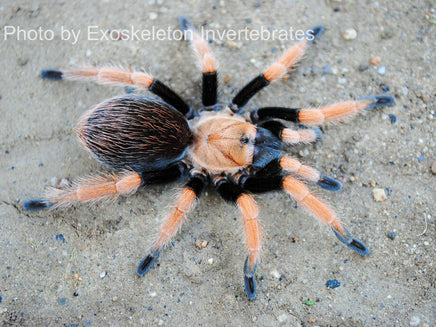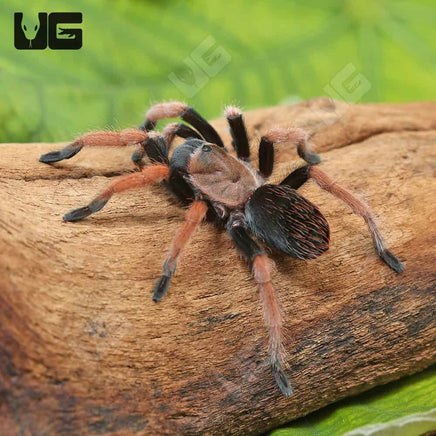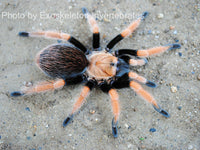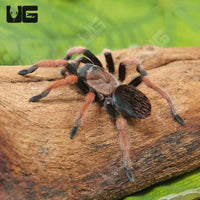🕷️ Aphonopelma bicoloratum – Mexican Blood Leg Tarantula
Subtle, elegant, and one of the most stunning Aphonopelma species in the hobby. Aphonopelma bicoloratum brings a clean contrast—jet black body, soft orange-red legs, and a calm, almost statuesque temperament. This is a slow-growing, long-living species that does everything on its own time. Rarely defensive, always beautiful. If you like quiet confidence in your tarantulas, this is the one.
🕸️ Care Details:
- Temperature: 75°F to 85°F is ideal. Can handle cooler temps as well, thanks to their desert-native tolerance.
- Humidity: Keep humidity around 50%. These come from dry regions, so a mostly dry setup with a lightly moistened corner is perfect. No misting needed—just keep ventilation up.
-
Housing (Terrestrial species):
- Babies: A 1oz to 4oz deli cup with pinhole ventilation works perfectly. Free container available—just ask at checkout or it won’t be included.
- Juveniles: 2 to 3 times their size, with dry substrate and a small hide.
- Adults: Minimum of 10”x8” enclosure. Use dry coco fiber, a cork hide, and some natural decor like stones or dry moss. Not a big digger, so you don’t need deep substrate.
🪳 Feeding:
They’re light eaters compared to faster-growing species, but they do eat well with a steady schedule.
Crickets and roaches like Dubia and red runners are great.
For babies, I use pinheads or small roaches.
If you only have larger feeders, crush the head and leave it in—they’ll scavenge without issue.
They don’t need overfeeding. Once every 7–10 days is perfect.
🔍 In-Depth Facts:
- Latin name: Aphonopelma bicoloratum
- Common names: Mexican Blood Leg Tarantula
- Locale: Central and southern Mexico—dry scrublands and arid desert edges
- Category: Terrestrial – slow-moving, calm, and often found lounging in the open or near its hide
- Size: Females can grow up to 5–5.5 inches; males slightly smaller and leggier
- Urticating hairs: Yes—but rarely kicks. One of the most mellow species I’ve kept
- Growth rate: Very slow. This species takes its time, but it’s worth the wait
- Life span: Females can live over 25 years; males around 4–5 years
- Recommended levels: Perfect for everyone—from total beginners to serious collectors. Great for display, and one of the calmest tarantulas out there.
Stay Connected:
- Instagram – Photos, updates, and feeding clips
- YouTube – Care videos and species overviews
- Facebook – Reviews and feedback from the community
- TikTok – Quick clips and tarantula content
⚠️ Safety Disclaimer:
Experiencing a tarantula bite is an extremely rare occurrence, and it's important to note that there have been no recorded fatalities due to a tarantula bite. The venom potency varies across species, with Old World tarantulasgenerally having stronger venom than their New World counterparts. Within the Old World category, the Poecilotheriagenus is known for having particularly potent venom.
It's crucial to approach tarantulas with respect and understanding. If you happen to get bitten, which is unlikely, the key is to stay calm. In most cases, the discomfort is superficial and subsides within a few minutes to a few hours. However, bites from species with more potent venom may result in symptoms lasting up to a week. Remember, larger tarantulas tend to have more venom than smaller ones.
Please be aware that I cannot assume responsibility for bites. Tarantula handling should be done at your own risk. In my 11 years of experience with these creatures, I have only been bitten once, by a species with highly potent venom. While the experience was painful, the symptoms had completely disappeared after a week.
Handle tarantulas responsibly, and always prioritize your safety and the well-being of the tarantula.
Aphonopelma bicoloratum is what happens when desert simplicity meets timeless beauty. It’s calm, classic, and makes a perfect long-term companion in any collection. Just don’t forget to ask for that free deli cup at checkout if you’re picking up a baby!



